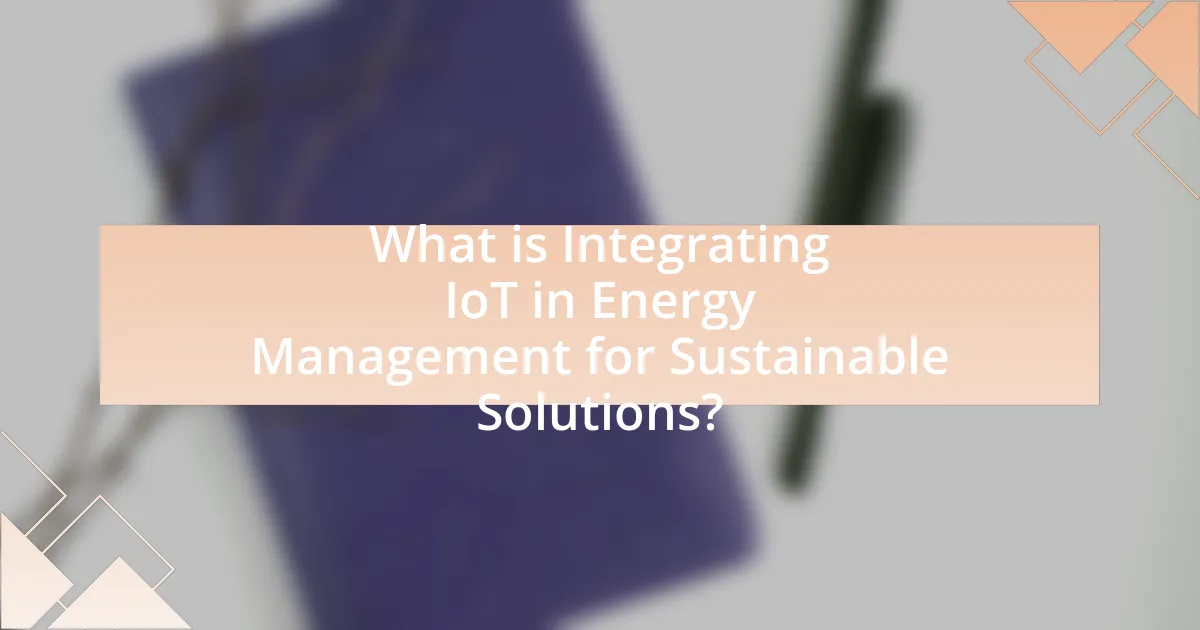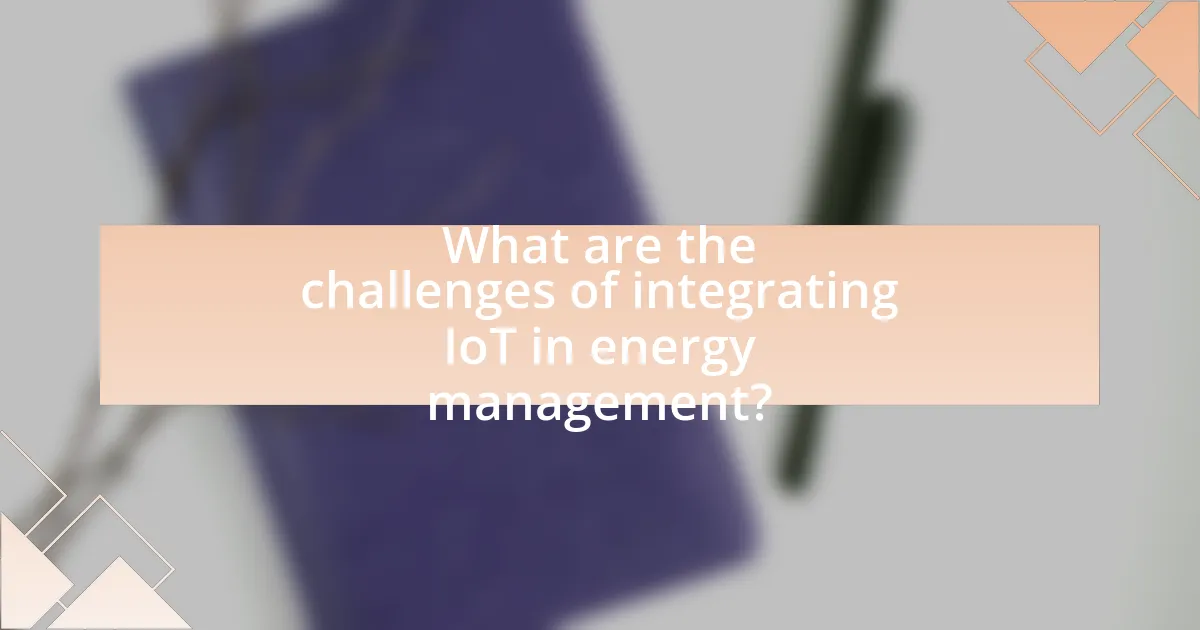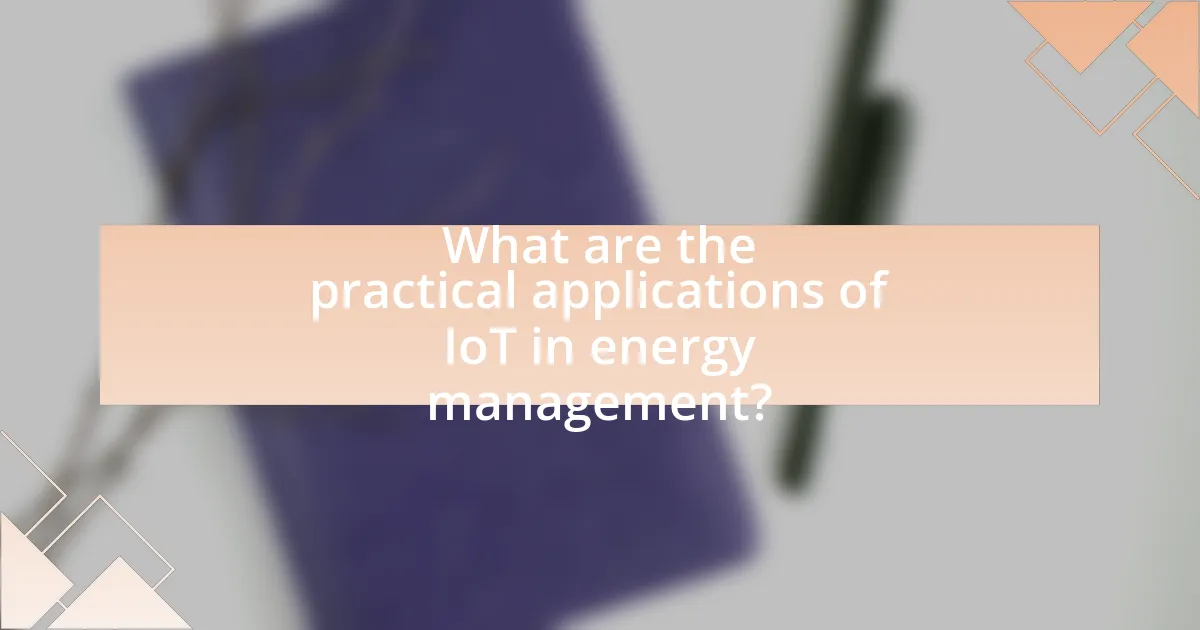Integrating IoT in energy management for sustainable solutions focuses on utilizing Internet of Things technology to optimize energy consumption and enhance efficiency in energy systems. Key components include smart meters, sensors, data analytics, and communication networks, which facilitate real-time monitoring and control of energy usage. The article discusses how IoT enhances energy management by identifying inefficiencies, promoting sustainability, and reducing carbon footprints, while also addressing challenges such as data security and interoperability. Practical applications in smart grids and commercial buildings demonstrate the effectiveness of IoT in achieving significant energy savings and operational improvements.

What is Integrating IoT in Energy Management for Sustainable Solutions?
Integrating IoT in energy management for sustainable solutions involves utilizing Internet of Things technology to optimize energy consumption and enhance efficiency in energy systems. This integration allows for real-time monitoring and control of energy usage through connected devices, leading to reduced waste and improved resource management. For instance, smart meters and sensors can provide data analytics that inform users about their energy consumption patterns, enabling them to make informed decisions that promote sustainability. Research indicates that implementing IoT in energy management can lead to energy savings of up to 30%, demonstrating its effectiveness in fostering sustainable practices.
How does IoT technology enhance energy management systems?
IoT technology enhances energy management systems by enabling real-time monitoring and control of energy consumption. This capability allows organizations to optimize energy usage, reduce waste, and improve efficiency. For instance, IoT sensors can track energy usage patterns and provide data analytics, which helps in identifying peak usage times and potential savings. According to a report by the International Energy Agency, implementing IoT solutions in energy management can lead to energy savings of up to 30%. This data-driven approach not only supports sustainability goals but also contributes to cost reductions and improved operational performance.
What are the key components of IoT in energy management?
The key components of IoT in energy management include smart meters, sensors, data analytics, communication networks, and cloud computing. Smart meters enable real-time monitoring of energy consumption, allowing for precise data collection. Sensors gather environmental and operational data, which is crucial for optimizing energy use. Data analytics processes this information to identify patterns and inefficiencies, facilitating informed decision-making. Communication networks ensure seamless data transfer between devices and systems, while cloud computing provides the infrastructure for data storage and processing, enabling scalability and accessibility. These components collectively enhance energy efficiency and sustainability in energy management systems.
How do sensors and data analytics contribute to energy efficiency?
Sensors and data analytics significantly enhance energy efficiency by providing real-time monitoring and insights into energy consumption patterns. These technologies enable the identification of inefficiencies and the optimization of energy use in various systems, such as HVAC, lighting, and industrial processes. For instance, a study by the U.S. Department of Energy found that implementing smart sensors in commercial buildings can reduce energy consumption by up to 30%. By analyzing data collected from these sensors, organizations can make informed decisions to adjust operations, leading to reduced energy waste and lower operational costs.
Why is sustainable energy management important?
Sustainable energy management is important because it reduces environmental impact while optimizing energy use. By implementing sustainable practices, organizations can decrease greenhouse gas emissions, which contribute to climate change. For instance, the International Energy Agency reported that energy efficiency improvements could reduce global energy demand by 12% by 2040, significantly lowering carbon emissions. Additionally, sustainable energy management promotes resource conservation, ensuring that energy sources remain available for future generations. This approach not only supports ecological balance but also enhances economic stability by reducing energy costs and fostering innovation in renewable technologies.
What role does IoT play in promoting sustainability?
IoT plays a crucial role in promoting sustainability by enabling real-time monitoring and management of resources, which leads to reduced waste and optimized energy consumption. For instance, smart sensors in buildings can track energy usage patterns, allowing for adjustments that minimize energy waste, resulting in up to 30% energy savings according to the U.S. Department of Energy. Additionally, IoT devices facilitate efficient water management by detecting leaks and monitoring usage, which can reduce water waste by 20-30%. These applications demonstrate how IoT technologies contribute to sustainable practices across various sectors.
How can IoT solutions reduce carbon footprints?
IoT solutions can reduce carbon footprints by optimizing energy consumption and enhancing resource management. For instance, smart meters and connected devices enable real-time monitoring of energy usage, allowing for more efficient energy distribution and reducing waste. According to a report by the International Energy Agency, implementing IoT technologies in buildings can lead to energy savings of up to 30%, significantly lowering greenhouse gas emissions. Additionally, IoT-enabled smart grids facilitate the integration of renewable energy sources, further decreasing reliance on fossil fuels and contributing to a reduction in overall carbon emissions.

What are the challenges of integrating IoT in energy management?
The challenges of integrating IoT in energy management include data security, interoperability, and scalability. Data security is critical as IoT devices can be vulnerable to cyberattacks, potentially compromising sensitive energy usage information. Interoperability poses a challenge because various IoT devices and platforms may not communicate effectively, leading to inefficiencies in energy management systems. Scalability is also a concern, as expanding IoT networks can require significant infrastructure investment and may face limitations in processing large volumes of data. These challenges must be addressed to fully leverage IoT for efficient energy management.
What security concerns arise with IoT in energy systems?
Security concerns with IoT in energy systems include vulnerabilities to cyberattacks, data breaches, and unauthorized access to critical infrastructure. These vulnerabilities arise from the interconnected nature of IoT devices, which can be exploited by malicious actors to disrupt energy supply, manipulate data, or gain control over operational systems. For instance, the 2015 cyberattack on Ukraine’s power grid demonstrated how IoT vulnerabilities could lead to significant outages, affecting millions of people. Additionally, inadequate security protocols in IoT devices can result in sensitive data being exposed, leading to privacy violations and potential regulatory non-compliance.
How can data privacy be ensured in IoT applications?
Data privacy in IoT applications can be ensured through robust encryption, secure authentication, and regular software updates. Implementing end-to-end encryption protects data during transmission, making it inaccessible to unauthorized users. Secure authentication methods, such as multi-factor authentication, verify user identities and prevent unauthorized access to devices. Regular software updates address vulnerabilities and enhance security measures, ensuring that IoT devices remain resilient against emerging threats. According to a report by the Internet of Things Security Foundation, 70% of IoT devices lack adequate security measures, highlighting the necessity of these practices to safeguard user data effectively.
What measures can be taken to protect against cyber threats?
To protect against cyber threats, organizations should implement a multi-layered security approach that includes strong access controls, regular software updates, and employee training. Strong access controls, such as multi-factor authentication, limit unauthorized access to sensitive systems and data. Regular software updates patch vulnerabilities that cybercriminals may exploit, reducing the risk of attacks. Employee training enhances awareness of phishing and social engineering tactics, which are common methods used to breach security. According to the Cybersecurity & Infrastructure Security Agency, organizations that adopt these measures significantly reduce their risk of cyber incidents.
How can interoperability be achieved in IoT energy solutions?
Interoperability in IoT energy solutions can be achieved through the adoption of standardized communication protocols and data formats. These standards, such as MQTT, CoAP, and OCPP, facilitate seamless data exchange between diverse devices and platforms, ensuring compatibility and integration. For instance, the Open Charge Point Protocol (OCPP) enables different electric vehicle charging stations to communicate with various management systems, promoting interoperability across manufacturers. Additionally, implementing middleware solutions can bridge gaps between incompatible systems, allowing for effective data sharing and control. This approach not only enhances system efficiency but also supports the scalability of IoT energy solutions in diverse environments.
What standards are necessary for effective integration?
Effective integration of IoT in energy management requires adherence to standards such as interoperability, data security, and scalability. Interoperability ensures that different IoT devices and systems can communicate seamlessly, which is crucial for efficient energy management. Data security standards protect sensitive information from breaches, maintaining user trust and regulatory compliance. Scalability allows systems to grow and adapt to increasing data and device numbers without compromising performance. These standards are supported by frameworks like the Open Connectivity Foundation, which promotes interoperability, and the ISO/IEC 27001 standard for information security management, reinforcing the importance of these criteria in achieving effective integration.
How do different IoT devices communicate within energy management systems?
Different IoT devices communicate within energy management systems primarily through standardized protocols such as MQTT, CoAP, and HTTP. These protocols enable devices to exchange data efficiently, allowing for real-time monitoring and control of energy consumption. For instance, MQTT (Message Queuing Telemetry Transport) is lightweight and ideal for low-bandwidth, high-latency networks, making it suitable for devices like smart meters and sensors. CoAP (Constrained Application Protocol) is designed for constrained devices and networks, facilitating communication in environments with limited resources. HTTP (Hypertext Transfer Protocol) is commonly used for web-based applications, allowing devices to interact with cloud services for data analysis and storage. The use of these protocols ensures interoperability among diverse IoT devices, enhancing the overall functionality of energy management systems.

What are the practical applications of IoT in energy management?
The practical applications of IoT in energy management include real-time monitoring, predictive maintenance, and demand response systems. Real-time monitoring allows for the continuous tracking of energy consumption, enabling organizations to identify inefficiencies and optimize usage. Predictive maintenance utilizes IoT sensors to forecast equipment failures, reducing downtime and maintenance costs. Demand response systems leverage IoT technology to adjust energy consumption based on grid demand, enhancing energy efficiency and stability. According to a report by the International Energy Agency, implementing IoT solutions can lead to energy savings of up to 15% in industrial settings, demonstrating the effectiveness of these applications in promoting sustainable energy management.
How is IoT used in smart grids?
IoT is used in smart grids to enhance energy management through real-time data collection and analysis. By deploying sensors and smart meters, IoT enables utilities to monitor energy consumption patterns, detect outages, and optimize energy distribution. For instance, a study by the U.S. Department of Energy indicates that smart grid technologies can reduce energy consumption by up to 15% through improved efficiency and demand response capabilities. This integration of IoT facilitates better decision-making, leading to a more reliable and sustainable energy system.
What benefits do smart grids provide to consumers and utilities?
Smart grids provide enhanced reliability, efficiency, and cost savings for both consumers and utilities. For consumers, smart grids enable real-time monitoring of energy usage, allowing for better management of consumption and potential reductions in energy bills. Utilities benefit from improved demand response capabilities, which help balance supply and demand, reduce peak load pressures, and minimize outages. According to the U.S. Department of Energy, smart grid technologies can reduce energy costs by up to 20% for consumers and improve operational efficiency for utilities by up to 30%.
How does real-time monitoring improve grid reliability?
Real-time monitoring improves grid reliability by enabling immediate detection and response to anomalies and outages. This capability allows grid operators to identify issues such as equipment failures or demand surges as they occur, facilitating swift corrective actions that minimize downtime. For instance, a study by the U.S. Department of Energy highlights that real-time monitoring systems can reduce outage durations by up to 30%, significantly enhancing overall grid performance. By continuously analyzing data from sensors and smart devices, operators can optimize energy distribution and prevent cascading failures, thereby ensuring a more stable and resilient energy supply.
What role does IoT play in building energy management systems?
IoT plays a crucial role in building energy management systems by enabling real-time monitoring and control of energy consumption. Through the deployment of smart sensors and connected devices, IoT facilitates the collection of data on energy usage patterns, allowing for more efficient energy management strategies. For instance, a study by the International Energy Agency indicates that IoT technologies can reduce energy consumption in buildings by up to 30% through optimized resource allocation and predictive maintenance. This integration of IoT not only enhances operational efficiency but also supports sustainability goals by minimizing waste and lowering carbon footprints.
How can IoT optimize energy consumption in commercial buildings?
IoT can optimize energy consumption in commercial buildings by enabling real-time monitoring and control of energy usage through connected devices. These devices, such as smart meters and sensors, collect data on energy consumption patterns, allowing building managers to identify inefficiencies and adjust systems accordingly. For instance, a study by the American Council for an Energy-Efficient Economy found that IoT applications can reduce energy consumption by up to 30% in commercial buildings by automating lighting and HVAC systems based on occupancy and environmental conditions. This data-driven approach not only enhances energy efficiency but also contributes to cost savings and sustainability goals.
What technologies are used for smart building automation?
Smart building automation utilizes technologies such as Internet of Things (IoT) devices, Building Management Systems (BMS), sensors, and artificial intelligence (AI). IoT devices enable real-time data collection and communication between various building systems, while BMS integrates and manages these systems for optimal performance. Sensors monitor environmental conditions, occupancy, and energy usage, providing critical data for decision-making. AI algorithms analyze this data to enhance energy efficiency and automate processes, leading to sustainable energy management solutions. These technologies collectively contribute to improved operational efficiency and reduced energy consumption in smart buildings.
What are the best practices for implementing IoT in energy management?
The best practices for implementing IoT in energy management include establishing a clear strategy, ensuring robust data security, integrating with existing systems, and utilizing real-time analytics. A clear strategy defines specific goals, such as reducing energy consumption or improving efficiency, which guides the implementation process. Robust data security measures protect sensitive information and maintain user trust, as IoT devices can be vulnerable to cyber threats. Integrating IoT solutions with existing energy management systems enhances functionality and streamlines operations, allowing for seamless data flow. Utilizing real-time analytics enables immediate insights into energy usage patterns, facilitating timely decision-making and optimization of energy resources. These practices are supported by industry reports indicating that organizations adopting IoT in energy management can achieve up to a 30% reduction in energy costs and improve operational efficiency by 25%.
How can organizations ensure successful IoT integration?
Organizations can ensure successful IoT integration by establishing a clear strategy that aligns with their business objectives. This involves identifying specific use cases for IoT applications, such as energy monitoring or predictive maintenance, which can lead to improved efficiency and cost savings. According to a report by McKinsey, companies that define their IoT strategy and objectives upfront are 2.5 times more likely to achieve significant value from their IoT investments. Additionally, organizations should invest in robust cybersecurity measures to protect their IoT devices and data, as vulnerabilities can lead to significant operational risks. Implementing a scalable infrastructure that supports data collection and analysis is also crucial, as it enables organizations to leverage real-time insights for decision-making.
What strategies can be employed to maximize energy savings?
To maximize energy savings, implementing smart energy management systems that utilize IoT technology is essential. These systems enable real-time monitoring and control of energy consumption, allowing for data-driven decisions that optimize usage. For instance, smart thermostats can adjust heating and cooling based on occupancy patterns, leading to significant reductions in energy waste. According to a study by the American Council for an Energy-Efficient Economy, homes equipped with smart thermostats can save an average of 10-12% on heating and cooling costs annually. Additionally, integrating IoT sensors in lighting systems can ensure lights are only on when needed, further enhancing energy efficiency.